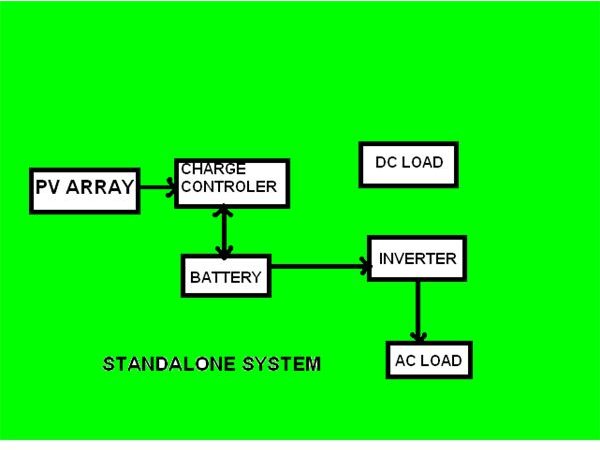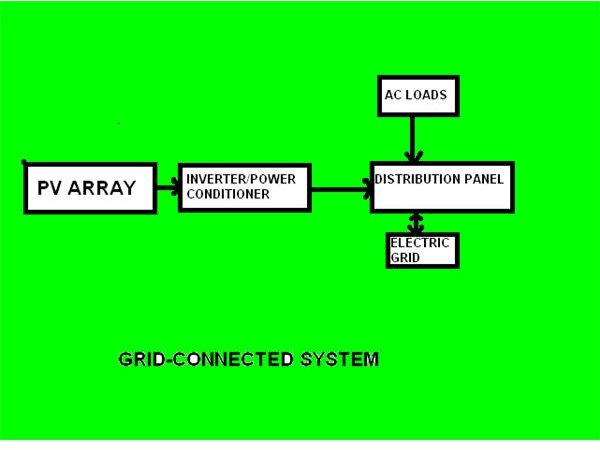Components in a PV System; PV System Diagram
A photovoltaic system offers a way to generate clean, quiet, and reliable energy. The acronym PV is a combination of two words; ‘photo’ and ‘voltaic’. The word photo represents light, and the meaning of voltaic is ‘producing electricity’. The whole word explains that it is a device that produces electricity from light.
Grid-Connected PV System
In a grid-connected PV system the electricity generated from the sunlight is directly transferred to the electricity utility grid. The size of grid-connected system may vary from residential with the capacity of 2-10 Kwp to a solar power station having the capacity of 10s of Gwp.
The DC power developed from the PV array must be converted to AC so it can be transfered to the electric grid. To do so, a grid-controlled inverter is used in this system.
When you are using this type of PV system it is essential to ensure that the system will not feed electricity to the electric grid if it is down for repair. Therefore saftey control systems are also required.
How the Grid-Connected PV System Works
In the diagram to the right is a simple explanation of the workings of a grid connected system. The electricity generated from the PV array is transferred to the primary component of the system, a power conditioner unit or inverter. This component converts the DC power developed in PV array to AC power for household usage. The AC power is transferred to the distribution panel. The distribution panel distributes the electricity throughout your home, and if the electricity quantity is greater than the on-site demand it feeds the extra amount of electricity to the electric grid (and you get a credit from the electric company on your bill).
Components of Grid-Connected PV System
PV Array
This is the most important component for all types of PV systems. It consists of photovoltaic cells. When the sunlight hits one the silicon wafers in it generate electricity. The energy of sunlight excites the free electrons of the silicon and releases them from their bonds to generate electricity.
Power Conditioner or Inverter
The next component used in the process is inverter. This is used for converting DC power to AC to use in households and to feed in electric grid. This inverter also synchronizes and improves electricity quality so that it can be freely fed to the grid.
Distribution Panel
The distribution panel is a component to divide the electric power to the AC loads and electric grid.
AC Load
This is nothing but the electric devices that require AC power to work. The AC power from the distribution panel is then supplied to the household electric devices for the further use of electricity.
Electric Grid
The electricity that exceeds the demand is transferred to the electric grid so that it can be used in other areas. If the PV system may not develop the required amount of electricity then this component is also used for fulfilling the demand from other external electric source.
Standalone PV System
This system doesn’t have any connection to the electricity mains like a grid-connected system. It is used in very small devices like watches and calculators up to machines as large and complex as spacecraft. It uses a battery (or bank of batteries depending on the size of the system) to store the DC power generated from the PV array.
How the Standalone PV System Works

This PV system doesn’t use a distribution panel; however, it has a charge controller to control the flow of electricity. The DC power generated from the PV array is transferred to the charge controller. This component distributes the electricity to DC loads such as ventilation fans, water pumps and small circulation pumps. The electricity that exceeds the demand is transferred to the battery. The battery stores the electricity, and sends it to the inverter whenever requires. The inverter is then converts the DC power to AC power and distributes it to the AC load.
Components of Standalone PV System
Most of the components of this system are similar to the grid-connected system such as PV array, inverter, AC load. Three other components are included in it, which are charge controller, DC load, and Battery.
Charge controller
The charge controller is very important in this type of PV system. It is used to avoid any damage in battery during excessive charging and discharging.
DC load
This component includes the devices that require DC current to operate. In this system, the electricity developed from the PV array can also be used directly to such electric devices. There are some off-grid homes that run entirely on DC power without the need for an AC inverter.
Battery
Batteries are used in this system to store electrical energy during the day to be able to supply it when it is required (for example; in lighting at night). The battery system enables the PV array to work at its maximum power point, and to supply electricity at stable voltage.
Hybrid PV System
A hybrid system uses some other electricity sources such as diesel generator, biogas, wind power, etc. with PV array. The use of other power sources is usually just to compensate for excessive electrical demands during peak periods of the day.
Conclusion
The PV system is being used worldwide due to its unique merits and advantages over other conventional power generation systems. It can be designed for various operational requirements. It can be used for your house and also as a distributed power generator. However, the components in a PV system require an initial investement in pricey PV cells thus limiting the use of this technology in poor areas where it could be of the most use.
References
- “Solar Electricity Basics”, Florida Solar Energy Center, https://www.fsec.ucf.edu/en/consumer/solar_electricity/basics/index.htm
- “A Photovoltaic System”, Top Alternative Energy Sources, https://www.top-alternative-energy-sources.com/photovoltaic-system.html
- “Solar Photovoltaic System”, Creat Green Home, https://www.creategreenhome.com/Solar_Photovoltaic_System.htm
